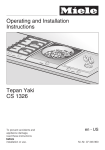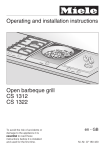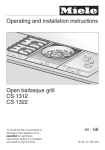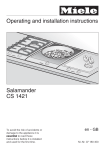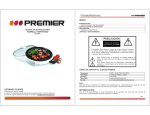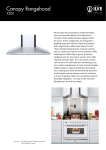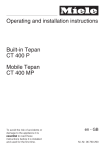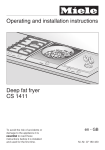Download Operating Instruction
Transcript
Operating and installation instructions Stainless steel TepanYaki CS 1327 To avoid the risk of accidents or damage to the appliance it is essential to read these instructions before it is installed and used for the first time. en - GB M.-Nr. 09 054 670 Contents Guide to the appliance . . . . . . . . . . . . . . . . . . . . . . . . . . . . . . . . . . . . . . . . . . . . . 3 Warning and Safety instructions . . . . . . . . . . . . . . . . . . . . . . . . . . . . . . . . . . . . . 4 Caring for the environment . . . . . . . . . . . . . . . . . . . . . . . . . . . . . . . . . . . . . . . . . 11 Before using for the first time. . . . . . . . . . . . . . . . . . . . . . . . . . . . . . . . . . . . . . . 12 Operation . . . . . . . . . . . . . . . . . . . . . . . . . . . . . . . . . . . . . . . . . . . . . . . . . . . . . . . 13 Switching on and off . . . . . . . . . . . . . . . . . . . . . . . . . . . . . . . . . . . . . . . . . . . . . . . 13 Residual heat indicator . . . . . . . . . . . . . . . . . . . . . . . . . . . . . . . . . . . . . . . . . . . . . 13 Settings . . . . . . . . . . . . . . . . . . . . . . . . . . . . . . . . . . . . . . . . . . . . . . . . . . . . . . . . . 14 Tips . . . . . . . . . . . . . . . . . . . . . . . . . . . . . . . . . . . . . . . . . . . . . . . . . . . . . . . . . . . . 15 Cleaning and care . . . . . . . . . . . . . . . . . . . . . . . . . . . . . . . . . . . . . . . . . . . . . . . . 16 Problem solving guide . . . . . . . . . . . . . . . . . . . . . . . . . . . . . . . . . . . . . . . . . . . . 18 Optional accessories . . . . . . . . . . . . . . . . . . . . . . . . . . . . . . . . . . . . . . . . . . . . . . 19 Safety instructions for installation . . . . . . . . . . . . . . . . . . . . . . . . . . . . . . . . . . . 20 Appliance and building-in dimensions . . . . . . . . . . . . . . . . . . . . . . . . . . . . . . . 24 Preparing the worktop . . . . . . . . . . . . . . . . . . . . . . . . . . . . . . . . . . . . . . . . . . . . . 25 Installation of several appliances. . . . . . . . . . . . . . . . . . . . . . . . . . . . . . . . . . . . 26 Fixing the spring clamps and spacer bars . . . . . . . . . . . . . . . . . . . . . . . . . . . . 28 Installing the appliance(s) . . . . . . . . . . . . . . . . . . . . . . . . . . . . . . . . . . . . . . . . . . 30 General installation tips . . . . . . . . . . . . . . . . . . . . . . . . . . . . . . . . . . . . . . . . . . . 31 Electrical connection . . . . . . . . . . . . . . . . . . . . . . . . . . . . . . . . . . . . . . . . . . . . . . 32 After sales service, data plate, guarantee . . . . . . . . . . . . . . . . . . . . . . . . . . . . . 34 2 Guide to the appliance a Rear cooking zone b Front cooking zone c Symbols to indicate which cooking zone the controls are for d Indicators e Control for rear cooking zone f Control for front cooking zone Indicators g In-operation indicator h Temperature indicator light i Residual heat indicator 3 Warning and Safety instructions This appliance complies with all current safety requirements. Inappropriate use can, however, lead to personal injury and damage to property. To avoid the risk of accidents and damage to the appliance, please read these instructions carefully before installation and before using it for the first time. They contain important notes on installation, safety, use and maintenance. Miele cannot be held liable for damage caused by non-compliance with these Warning and Safety instructions. Keep these instructions in a safe place and ensure that new users are familiar with the content. Pass them on to any future owner. 4 Warning and Safety instructions Correct application ~ This Tepan Yaki is not designed for commercial use. It is intended for use in domestic households and similar working and residential environments. ~ The appliance is not intended for outdoor use. ~ It is intended for domestic use only to cook food and keep it warm. Any other use is not supported by the manufacturer and could be dangerous. ~ The appliance can only be used by people with reduced physical, sensory or mental capabilities, or lack of experience and knowledge, if they are supervised whilst using it, or have been shown how to use it in a safe way and understand the hazards involved. 5 Warning and Safety instructions Safety with children ~ Children under 8 years of age must be kept away from the appliance unless they are constantly supervised. ~ Children 8 years and older may only use the appliance if they have been shown how to use it in a safe way and understand the hazards involved. ~ Children must not be allowed to clean the appliance unsupervised. ~ This appliance is not a toy! To prevent the risk of injury, do not allow children to play with the appliance or its controls. ~ The appliance gets hot when in use and remains hot for a while after being switched off. Keep children well away from the appliance until it has cooled down and there is no danger of burning. ~ Danger of suffocation. Packaging, e.g. cling film, polystyrene and plastic wrappings, must be kept out of the reach of babies and children. Whilst playing, children could become entangled in packaging, ( e.g. plastic wrapping) or pull it over their head and suffocate. ~ Danger of burning. Do not store anything which might arouse a child's interest in storage areas above or behind the appliance. Otherwise they could be tempted into climbing onto the appliance 6 Warning and Safety instructions Technical safety ~ Installation, maintenance and repairs may only be carried out by a Miele-authorised person. Installation, maintenance and repairs by unqualified persons could be dangerous. ~ A damaged appliance can be dangerous. Check the appliance for visible signs of damage. Do not use a damaged appliance. ~ The electrical safety of this appliance can only be guaranteed if correctly earthed. It is most important that this basic safety requirement is observed and regularly tested, and where there is any doubt, the household wiring system should be inspected by a qualified electrician. ~ To avoid the risk of damage to the appliance, make sure that the connection data (frequency and voltage) on the data plate corresponds to the household supply, before connecting the appliance to the mains supply. Consult a qualified electrician if in any doubt. ~ Do not connect the appliance to the mains electricity supply by a multi-socket adapter or an extension lead. These are a fire hazard and do not guarantee the required safety of the appliance. ~ For safety reasons, this appliance may only be used after it has been built in. ~ This appliance must not be used in a non-stationary location (e.g. on a ship). 7 Warning and Safety instructions ~ Do not open the casing of the appliance. Tampering with electrical connections or components and mechanical parts is highly dangerous to the user and can cause operational faults. ~ While the appliance is under guarantee, repairs should only be undertaken by a service technician authorised by Miele. Otherwise the guarantee is invalidated. ~ The manufacturer can only guarantee the safety of the appliance when original Miele replacement parts are used. Faulty components must only be replaced by genuine Miele original spare parts. ~ The appliance is not intended for use with an external timer switch or a remote control system. ~ If the plug is removed from the connection cable or if the appliance is supplied without a plug, the appliance must be connected to the electrical supply by a suitably qualified electrician. If the connection cable is faulty, it must be replaced with a special connection cable. See "Electrical connection". ~ The appliance must be disconnected from the mains electricity supply during installation, maintenance and repair work. Ensure that power is not supplied to the appliance until after it has been installed or until any maintenance or repair work has been carried out. ~ Do not use the appliance if it is faulty. Switch it off immediately and disconnect it from the mains electricity supply. ~ In areas which may be subject to infestation by cockroaches or other vermin, pay particular attention to keeping the appliance and its surroundings clean at all times. Any damage caused by cockroaches or other vermin will not be covered by the guarantee. 8 Warning and Safety instructions Correct use ~ Oil and fat are potential fire hazards as they can ignite if overheated. Do not leave the appliance unattended when cooking with oil or fat. If oil or fat does catch fire, do not attempt to put out the flames with water. Disconnect the appliance from the mains and use a suitable fire blanket, saucepan lid, damp towel or similar to smother the flames. ~ Flames could set the grease filters of a cooker hood on fire. Do not flambé under a cooker hood. ~ Spray canisters, aerosols and other inflammable substances can ignite when heated. Therefore do not store such items or substances in a drawer under the appliance. Cutlery inserts must be heat-resistant. ~ Do not heat up unopened tins of food on the appliance, as pressure will build up in the tin, causing it to explode. ~ Do not cover the appliance, e.g. with a hob cover, a cloth or protective foil. The material could catch fire, shatter or melt if the appliance is switched on by mistake or if residual heat is still present. ~ When using an electrical appliance, e.g. a hand-held food blender, near the appliance, ensure that the cable of the electrical appliance cannot come into contact with the hot appliance. The insulation on the cable could become damaged. ~ If the appliance is installed behind a kitchen furniture door, it may only be used with the furniture door open. Do not close the door whilst the appliance is in use or whilst there is any residual heat present. 9 Warning and Safety instructions ~ The appliance gets hot when in use and remains hot for a while after being switched off. There is a danger of burning until the residual heat indicator goes out. ~ You could burn yourself on the hot appliance. Protect your hands with heat-resistant pot holders or gloves when handling hot pots and pans. Do not let them get wet or damp, as this causes heat to transfer through the material more quickly with the risk of scalding or burning yourself. ~ Where several appliances are installed side by side Hot objects can damage the seal of the cover strip between the appliances. Do not place hot pans near or on the cover strip. ~ When the appliance is switched on either deliberately or by mistake, or when there is residual heat present, there is the risk of any metal items left on the appliance heating up, with the danger of burning. Depending on the material, other items left on the appliance could also melt or catch fire. Do not use the appliance as a resting place. Switch the cooking zones off after use. ~ Due to the high temperatures radiated, objects left near the appliance when it is in use could catch fire. Do not use the appliance to heat up the room. ~ The appliance becomes very hot. Do not use plastic utensils. Even heat-resistant plastic utensils are unsuitable. Cleaning and care ~ Danger of injury. Do not use a steam cleaning appliance to clean this appliance. The steam could reach electrical components and cause a short circuit. 10 Caring for the environment Disposal of the packing material The packaging is designed to protect the appliance from damage during transportation. The packaging materials used are selected from materials which are environmentally friendly for disposal and should be recycled. Recycling the packaging reduces the use of raw materials in the manufacturing process and also reduces the amount of waste in landfill sites. Disposal of your old appliance Electrical and electronic appliances often contain materials which, if handled or disposed of incorrectly could be potentially hazardous to human health and to the environment. They are, however, essential for the correct functioning of your appliance. Please do not therefore dispose of it with your household waste. Ensure that any plastic wrappings, bags, etc. are disposed of safely and kept out of the reach of babies and young children. Danger of suffocation. Please dispose of it at your local community waste collection/recycling centre or contact your dealer for advice. Ensure that it presents no danger to children while being stored for disposal. 11 Before using for the first time Please stick the extra data plate for the appliance supplied with this documentation in the space provided in the "service, data plate, guarantee" section of this booklet. Cleaning for the first time ^ Remove any protective foil and sticky labels. ^ Clean with a solution of washing up liquid in warm water, and dry with a soft cloth. Metal components have a protective coating which may give off a slight smell when heated up for the first time. The smell and any vapours will dissipate after a short time, and do not indicate a faulty connection or appliance. 12 Operation The Tepan plate is divided into two separate cooking zones which can be switched on and regulated independently of one another. The entire area can be used when cooking large quantities of food. When cooking smaller quantities, the front zone can be used for cooking whilst the rear zone can be used to keep food warm using a lower power setting. Switching on and off To switch the Tepan plate on, turn the control clockwise. To switch off, turn the control anti-clockwise. Only turn the control clockwise as far as "12" and anti-clockwise back to "0" again to switch it off. Do not attempt to turn it all the way round from the "12" position to "0" or vice versa. This will damage the control. After switching on, the in-operation indicator N and the temperature indicator % light up. The temperature indicator light will switch on and off intermittently in conjunction with the heating element. Residual heat indicator After switching off, the residual heat indicator lights up. The residual heat indicator remains on until the Tepan plate is cool enough to touch. Do not touch or place any heat sensitive objects on the Tepan plate while the residual heat indicator is still on. Danger of burning and fire hazard. 13 Operation Settings Cooking process Settings Keeping cooked food warm 1-2 Steaming fruit, e.g. apple slices, peach halves, sliced bananas, etc. 2-4 Gentle stir frying of chopped/sliced vegetables, e.g. leeks, mushrooms, green/red peppers, onion etc. 5-7 Gentle frying of breaded or battered fish 7-9 Rapid frying in succession of meat, fish fried eggs, pancakes, hash browns etc. 9 - 11 Frying potato pancakes, prawns, corn-on-the-cob 11 - 12 These settings are only a guide. The actual cooking time will depend on the type of food, its texture and thickness as well as personal taste. 14 Operation Tips Wipe the surface of the Tepan plate before each use with a damp cloth to remove any dust particles or other soiling which may have settled on it since it was last used. – Marinating often improves the flavour of food to be cooked. – Pat wet food dry with kitchen paper before cooking to prevent it spitting. – To prevent meat drying out, do not season with salt until after it has been cooked. – Pre-heat the Tepan plate thoroughly for 8 -10 minutes at the power level that you are going to be using for cooking. Pre-heat at power level 12 if you are going to be cooking at settings 9-12. – It is important to get the Tepan sufficiently hot before use, particularly when browning and sealing meat. If it is not hot enough, the meat will lose too much juice and become tough. – For frying only use the minimum amount of oil or fat. With marinated food, no fat or oil is needed. Wait until the temperature indicator light has gone out before adding cooking fat. – Only use fats and oils which can be heated to high temperatures. 15 Cleaning and care Miele offer a range of branded cleaning products. See "Optional accessories". ,Do not use a steam cleaner to clean this appliance. The steam could reach electrical components and cause a short circuit. The appliance should be cleaned after each use. Let it cool down to room temperature. To avoid water marks and limescale deposits, use a soft cloth to dry surfaces that have been cleaned with water. To avoid damaging the surface of your appliance, do not use: – cleaning agents containing soda, alkalines, ammonia, acids or chlorides, – cleaning agents containing descaling agents, – stain or rust removers, – abrasive cleaning agents, e.g. powder cleaners and cream cleaners, – solvent-based cleaning agents, – dishwasher cleaner, – grill and oven cleaners, – glass cleaning agents, – hard, abrasive brushes or sponges, e.g. pot scourers, brushes or sponges which have been previously used with abrasive cleaning agents, – sharp pointed objects (these can damage the seal between the frame and the worktop), – melamine eraser blocks. 16 Cleaning and care Stainless steel frame / control panel Follow the manufacturer's instructions when using a stainless steel cleaning agent. Frying surface Use a spatula to remove any large particles immediately. Allow the appliance to cool down until it can be touched by hand, and then use a solution of hot water and washing-up liquid to soften the soiling. Clean the surface with the pad of a non-scouring sponge and a few drops Miele Ceramic and stainless steel hob cleaning agent (see "Optional accessories"). Finally wipe with a damp cloth and dry thoroughly. Ensure that every trace of cleaning agent has been removed from the surface by wiping carefully with a damp cloth. Any remaining traces could affect food the next time you use the appliance. Clean the frame and the control panel with a few drops of Miele Ceramic and stainless steel hob cleaning agent (see "Optional accessories") and a soft, damp cloth. Printing (settings around the control knob) Do not use the ceramic and stainless steel hob cleaning agent on the printing as it would rub it off. These areas should be only cleaned with an E-Cloth or with a solution of warm water and a little washing-up liquid applied with a soft sponge. Control knobs Clean the control knobs with a solution of warm water and a little washing-up liquid applied with a soft sponge. Stubborn soiling should be soaked first. Finally dry all parts with a clean cloth. Important - Conditioning agents for stainless steel must not be used on the frying surface. 17 Problem solving guide What to do if... Installation work and repairs to electrical appliances must only be carried out by a suitably qualified and competent person in strict accordance with current local and national safety regulations. Repairs and other work by unqualified persons could be dangerous. The manufacturer cannot be held liable for unauthorised work. 18 ... after switching on, the appliance does not heat up Check whether the mains fuse has tripped. If it has, contact a qualified electrician or Miele. Optional accessories Miele offer a comprehensive range of useful accessories as well as cleaning and conditioning products for your Miele appliances. These can be ordered online at: or from Miele (see back cover for contact details). Ceramic and stainless steel hob cleaner 250 ml Removes heavy soiling, limescale deposits and light discolouration E-Cloth (microfibre cloth) Removes fingerprints and light soiling. 19 Safety instructions for installation To avoid the risk of damaging the TepanYaki fit the wall units and extractor hood before installing it. ~ The veneer or laminate coatings of worktops (or adjacent kitchen units) must be treated with 100 °C heat-resistant adhesive which will not dissolve or distort. Any backmoulds must be of heat-resistant material. ~ The TepanYaki must not be installed directly next to a salamander (CS 1421). It is essential to maintain a distance of at least 150 mm between these two appliances. ~ Connection should be made via a suitable isolator or a double pole fused spur connection unit which complies with current national and local safety regulations, and the on/off switch should be easily accessible after the appliance has been built in. See "Electrical connection" for more details. ~ The appliance must not be built in over a fridge, fridge-freezer, freezer, dishwasher, washing machine or tumble dryer. 20 ~ After installation, ensure that the connection cable cannot come into contact with the underside of the appliance. Make sure that there is no mechanical obstruction, such as a drawer, which could damage it. ~ Observe carefully the safety distances given on the following pages. All dimensions in this instruction booklet are given in mm. Safety instructions for installation Safety distance above the TepanYaki A minimum safety distance must be maintained between the Tepan plate and the cooker hood above it. See the cooker hood manufacturer's operating and installation instructions for details. If the manufacturer's instructions are not available for the cooker hood, a minimum safety distance of at least 760 mm must be maintained. For any flammable objects, e.g. utensil rails, wall units etc. a minimum distance of at least 760 mm must be maintained between them and the appliance below. When two or more appliances are installed together below a cooker hood, e.g. a TepanYaki and a gas hob combiset, which have different safety distances given in the installation instructions, you should select the greater distance of the two. 21 Safety instructions for installation Safety distances to the sides of the TepanYaki Ideally the appliance should be installed with plenty of space on either side. There may be a wall at the rear and a wall or a tall unit at one side. On the other side, however, no unit or divider should stand higher than the appliance. Due to the high temperatures radiated by the TepanYaki, it is essential that a minimum distance of 50 mm is maintained between the worktop cut-out and the back wall. Recommended The following minimum distance a between the worktop cut-out and a wall or tall unit to the right or left must be maintained: 40 mm for CS 1212 / CS 1212-1 CS 1221 / CS 1221-1 CS 1222 CS 1223 CS 1234 / CS 1234-1 50 mm for CS 1112 CS 1122 CS 1134 CS 1326 CS 1327 CS 1411 100 mm for CS 1012 / CS 1012-1 150 mm for CS 1421 CS 1312 CS 1322 200 mm for CS 1034 / CS 1034-1 250 mm for CS 1011 CS 1021 22 Not recommended Not allowed Safety instructions for installation Safety distance when installing the appliance near a wall with additional niche cladding A minimum safety distance must be maintained between the worktop cut-out and any niche cladding to protect it from heat damage. If the niche cladding is made from a combustible material (e. g. wood) a minimum safety distance e of 50 mm must be maintained between the cut-out and the cladding. If the niche cladding is made from a non-combustible material (e. g. metal, natural stone, ceramic tiles) a minimum safety distance e of 50 mm less the thickness of the cladding must be maintained between the cut-out and the cladding. Example: 15 mm niche cladding 50 mm - 15 mm = minimum safety distance of 35 mm a Masonry b Niche cladding Dimension x = thickness of niche cladding material c Worktop d Worktop cut-out e Minimum safety distance for combustible materials is 50 mm for non-combustible materials is 50 mm less dimension x 23 Appliance and building-in dimensions a Spring clamps b Front c Casing depth d Casing depth including mains connection box with mains connection cable, L = 1440 mm 24 Preparing the worktop ^ Make the worktop cut-out for one or more appliances in accordance with the building-in diagrams. Remember to maintain the minimum safety distance from the back wall, as well as from any tall unit or side wall to the right or left of the TepanYaki. See "Safety instructions for installation". ^ Seal the cut surfaces with a suitable heat-resistant sealant to avoid swelling caused by moisture. If, during installation, you find that the seals on the corners of the frame are not flush with the worktop surface, the corner radius (ß R4) can be carefully scribed to fit. 25 Installation of several appliances When installing two or more appliances next to each other a spacer bar b must be used between each one. See "Fixing the spring clamps and spacer bars". Worktop cut-out - two appliances Worktop cut-out - three appliances To calculate the cut-out width (D) required: Add up the widths of each appliance (e.g. 288 mm, 380 mm) and subtract 16 mm from this figure Number of appliances 26 Appliance width in mm Worktop cut-out in mm 1 288 288 - 16 = 272 2 288, 288 288 + 288 - 16 = 560 2 288, 380 288 + 380 - 16 = 652 3 288, 288, 288 288 + 288 + 288 - 16 = 848 3 288, 288, 380 288 + 288 + 380 - 16 = 940 Installation of several appliances a Spring clamps b Spacer bars c Gaps between spacer bars and worktop d Cover strips The illustration shows a worktop cut-out with spring clamps a and spacer bars b for 3 appliances. An additional spacer bar is required for each additional appliance. The position for securing each additional spacer bar will depend on the width of appliance B (288 mm / 380 mm / 576 mm). 27 Fixing the spring clamps and spacer bars Wooden worktops ^ Position the spring clamps supplied a and spacer bars b on the top edge of the cut-out in the positions marked. ^ Secure the spring clamps and spacer bars with the 3.5 x 25 mm screws supplied. 28 Fixing the spring clamps and spacer bars Granite and marble worktops The screws are not required for granite or marble worktops. ^ Apply silcone to the side edges and the lower edges of spring clamps a and spacer bars b. ^ Position and secure the spring clamps a and spacer bars b using strong, double-sided adhesive tape c. ^ Then fill gap e between the spacer bars and the worktop with silicone. 29 Installing the appliance(s) ^ Feed the connection cable down through the cut-out. ^ Starting at the front, position the next appliance in the worktop cut-out. ^ Starting at the front, position the appliance in the worktop cut-out. ^ Connect the appliance(s) to the mains (see "Electrical connection"). ^ Using both hands, press down evenly on the sides of the appliance until it clicks into position. When doing this make sure that the seal under the appliance sits flush with the worktop on all sides. This is important to ensure an effective seal all round. Do not use sealant. ^ Check that the appliance(s) work(s). ^ Push the appliance to the side until the holes in the spacer bar can be seen. ^ Fit the cover strip d into the holes in the spacer bar b. 30 Once installed, the appliance can only be removed using a special tool. It can also be pushed up out of the cut-out from below. It must be pushed up from the back first. General installation tips Seal between the appliance and the worktop Tiled worktop The sealing strip under the edge of the top part of the appliance provides a sufficient seal for the worktop. Grout lines a and the hatched area underneath the surface of the appliance must be smooth and even. If they are not, the appliance will not sit flush with the worktop and the sealing strip underneath the top part of the appliance will not provide a good seal between the appliance and the worktop. The appliance must not be sealed with sealant (e.g. silicone). This could result in damage to the appliance or the worktop if it ever needs to be removed for servicing. 31 Electrical connection All electrical work should be carried out by a suitably qualified and competent person in strict accordance with current local and national safety regulations (BS 7671 in the UK). Connection should be made via a fused plug and switched socket or a double pole fused spur connection unit, or a suitable isolator (as appropriate) which complies with national and local safety regulations and the on/off switch should be easily accessible after the appliance has been built in. If the connection cable is damaged, it must be replaced by a suitably qualified electrician with a special connection cable of type H 05 V V-F (pvc insulated), available from Miele. If the switch is not accessible after installation (depending on country) an additional means of disconnection must be provided for all poles. Installation, repairs and other work by unqualified persons could be dangerous. The manufacturer cannot be held liable for unauthorised work. Ensure power is not supplied to the appliance until after installation or repair work has been carried out. The appliance must only be operated when built-in. This is to ensure that all electrical parts are shielded. Live parts must not be exposed. Do not connect the appliance to the mains electricity supply by an extension lead. These do not guarantee the required safety of the appliance. Please make sure that the connection data quoted on the data plate match the household mains supply. 32 For extra safety it is advisable to protect the appliance with a suitable residual current device (RCD). When switched off there must be an all-pole contact gap of at least 3 mm in the isolator switch (including switch, fuses and relays). Important U.K. The appliance is supplied for connection to a 230-240 V, 50 Hz supply with a 3-core cable. The wires in the mains lead are coloured in accordance with the following code: Green/yellow = earth Blue = neutral Brown = live WARNING THIS APPLIANCE MUST BE EARTHED Electrical connection Important The electrical safety of this appliance can only be guaranteed when continuity is complete between the appliance and an effective earthing system, which complies with local and national regulations. It is most important that this basic safety requirement is present and tested regularly and if there is any doubt the electrical wiring in the home should be inspected by a qualified electrician. The manufacturer cannot be held liable for the consequences of an inadequate earthing system such as an electric shock. The manufacturer cannot be held liable for damage which is the direct or indirect result of incorrect installation or connection. 33 After sales service, data plate, guarantee In the event of any faults which you cannot remedy yourself, or if the appliance is under guarantee, please contact: – Your Miele dealer, or – the Miele Service Department (see back cover for address). Please note that telephone calls may be monitored and recorded to improve our service. When contacting Miele, please quote the model and serial number of your appliance which are given on the data plate. N.B. A call-out charge will be applied for service visits where the problem could have been resolved as described in these instructions. Space in which to stick the extra data plate supplied with the appliance. Ensure that the model number is the same as the one on the front of these instructions. Guarantee For information on the appliance guarantee specific to your country please contact Miele. See back cover for contact details. In the U.K. your appliance is guaranteed for 2 years from the date of purchase. However, you must activate your cover by calling 0845 365 6640 or registering online at www.miele.co.uk 34 35 Alteration rights reserved/ 5012 M.-Nr. 09 054 670 / 02






































